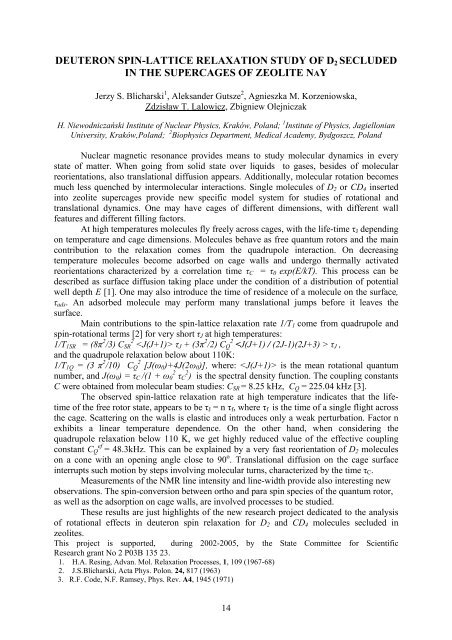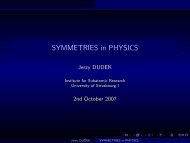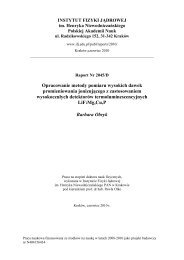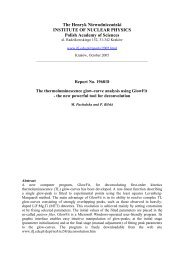Report No xxxx - Instytut Fizyki JÄ drowej PAN
Report No xxxx - Instytut Fizyki JÄ drowej PAN
Report No xxxx - Instytut Fizyki JÄ drowej PAN
Create successful ePaper yourself
Turn your PDF publications into a flip-book with our unique Google optimized e-Paper software.
DEUTERON SPIN-LATTICE RELAXATION STUDY OF D 2 SECLUDED<br />
IN THE SUPERCAGES OF ZEOLITE NAY<br />
Jerzy S. Blicharski 1 , Aleksander Gutsze 2 , Agnieszka M. Korzeniowska,<br />
Zdzisław T. Lalowicz, Zbigniew Olejniczak<br />
H. Niewodniczański Institute of Nuclear Physics, Kraków, Poland; 1 Institute of Physics, Jagiellonian<br />
University, Kraków,Poland; 2 Biophysics Department, Medical Academy, Bydgoszcz, Poland<br />
Nuclear magnetic resonance provides means to study molecular dynamics in every<br />
state of matter. When going from solid state over liquids to gases, besides of molecular<br />
reorientations, also translational diffusion appears. Additionally, molecular rotation becomes<br />
much less quenched by intermolecular interactions. Single molecules of D 2 or CD 4 inserted<br />
into zeolite supercages provide new specific model system for studies of rotational and<br />
translational dynamics. One may have cages of different dimensions, with different wall<br />
features and different filling factors.<br />
At high temperatures molecules fly freely across cages, with the life-time τ J depending<br />
on temperature and cage dimensions. Molecules behave as free quantum rotors and the main<br />
contribution to the relaxation comes from the quadrupole interaction. On decreasing<br />
temperature molecules become adsorbed on cage walls and undergo thermally activated<br />
reorientations characterized by a correlation time τ C = τ 0 exp(E/kT). This process can be<br />
described as surface diffusion taking place under the condition of a distribution of potential<br />
well depth E [1]. One may also introduce the time of residence of a molecule on the surface,<br />
τ ads . An adsorbed molecule may perform many translational jumps before it leaves the<br />
surface.<br />
Main contributions to the spin-lattice relaxation rate 1/T 1 come from quadrupole and<br />
spin-rotational terms [2] for very short τ J at high temperatures:<br />
1/T 1SR = (8π 2 /3) C 2 SR τ J + (3π 2 /2) C 2 Q τ J ,<br />
and the quadrupole relaxation below about 110K:<br />
1/T 1Q = (3 π 2 /10) C 2 Q [J(ω 0 )+4J(2ω 0 )], where: is the mean rotational quantum<br />
number, and J(ω 0 ) = τ C /(1 + ω 2 0 τ 2 C ) is the spectral density function. The coupling constants<br />
C were obtained from molecular beam studies: C SR = 8.25 kHz, C Q = 225.04 kHz [3].<br />
The observed spin-lattice relaxation rate at high temperature indicates that the lifetime<br />
of the free rotor state, appears to be τ J = n τ f , where τ f is the time of a single flight across<br />
the cage. Scattering on the walls is elastic and introduces only a weak perturbation. Factor n<br />
exhibits a linear temperature dependence. On the other hand, when considering the<br />
quadrupole relaxation below 110 K, we get highly reduced value of the effective coupling<br />
ef<br />
constant C Q = 48.3kHz. This can be explained by a very fast reorientation of D 2 molecules<br />
on a cone with an opening angle close to 90 o . Translational diffusion on the cage surface<br />
interrupts such motion by steps involving molecular turns, characterized by the time τ C .<br />
Measurements of the NMR line intensity and line-width provide also interesting new<br />
observations. The spin-conversion between ortho and para spin species of the quantum rotor,<br />
as well as the adsorption on cage walls, are involved processes to be studied.<br />
These results are just highlights of the new research project dedicated to the analysis<br />
of rotational effects in deuteron spin relaxation for D 2 and CD 4 molecules secluded in<br />
zeolites.<br />
This project is supported, during 2002-2005, by the State Committee for Scientific<br />
Research grant <strong>No</strong> 2 P03B 135 23.<br />
1. H.A. Resing, Advan. Mol. Relaxation Processes, 1, 109 (1967-68)<br />
2. J.S.Blicharski, Acta Phys. Polon. 24, 817 (1963)<br />
3. R.F. Code, N.F. Ramsey, Phys. Rev. A4, 1945 (1971)<br />
14

















